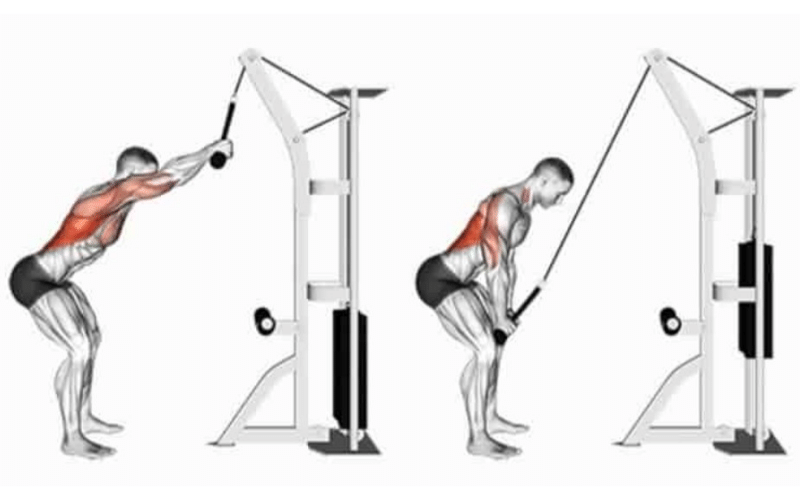Table of Contents

The cable pullover is an isolation exercise to work the lats, which are the large muscles in your upper back that provide width to your torso. The move also strengthens and expands your rib cage for better lung function.
Long Cable Pullovers build up endurance in your ribcage so you can stay fresh when doing presses or any throwing motion. They also train you to keep a strong posture while pulling down against resistance, which improves spinal strength over time.
Cable Pullover Muscles Worked?
Pullovers are primarily an upper back exercise that involves big muscles like lats, traps, mid-back muscles, rear delts and arm flexors.
Along with developing muscle strength it also helps to improve stability in the shoulder joint by training the rotator cuff muscles which are responsible for shoulder joint stabilization.
Primary: Latissimus Dorsi (Back) and Triceps Brachii (Lower Arms)
Secondary: Serratus Anterior, Deltoids
Stabilizers: Core Muscles, Including the Transverses Abdominis and Multifidus as Well as the Internal and External Obliques. Also, Trapezius Is Partially Involved
Tip: If you want a nice variation on the Cable Pullover try doing it on a bench with a dumb bell between your feet.
The weight of your feet will help you to stretch out your back as you pull up. This is a great move for sports that require lots of rotation of your torso, such as baseball or golf.
Cable Pullover Benefit
It increases your flexibility, particularly in the spine and ribcage which will improve your range of motion during rotation.
The pullover also improves upper back mobility. That’s useful for preventing injuries like rotator cuff tears.
It’s necessary strength for any movement that involves pulling something down above you (such as a pull up or row).
You can use weights to make it easier or harder, which changes the muscles worked. The cable pullover is also an effective core stability exercise, especially when you do them on one leg at a time (unilateral stance). It’s sometimes used as part of rehabilitation programs to help people recover from spinal injury.
How to Do Cable Pullover?
1: Start by adjusting the cable machine and pulling down the bar to a comfortable level of resistance. Then, grab the handle with your palms facing each other and hold tight.
Tip: Keep your core tight so you don’t arch your lower back when lifting over head
2: Lean back approximately two or three feet at 90 degrees from very low position. This is the starting point for the exercise before you begin to pull up in an arc above your chest. If necessary, adjust the height of the pulley for this movement to start in the right place.
3: Keeping your elbows in place, pull yourself up in an arc until bar touches just above upper chest then slowly return to original position bringing your arms behind your shoulders while keeping your elbows tucked in.
4: Do not allow your hips to rotate and maintain a flat back and strong core for the duration of the exercise.
How Many Sets?
3-4 sets of 12 reps with 30 seconds rest between each set is recommended for this exercise! Make sure not to have too much weight on pull overs which will cause more
Tip: If you want to make this move easier bring your hands closer together (so that they’re an inch away from each other) and pull up more directly above your chest.
If you want it harder, push them out so they’re wider than shoulder width apart before pulling yourself upward.
You can also change the height of where you start to ensure that you don’t bend at your waist as much as you pull up.
Cable Pullover for Chest
If you want to work your chest while doing Cable Pullovers, start with an overhand grip and pull the bar down until it’s under your chin.
This is a great way to add volume to your workout without wearing yourself out. It also works the back muscles in a different range of motion than rowing movements (like cable rows).
So it makes for a nice variation on those same movements.
Cable Pullover for Back
If you want to work the back muscles , start with an underhand grip and pull the bar down behind your head. The key here is maintaining a strong core throughout this movement. This ensures that all the work for your lats comes from doing the pulling action, not using momentum to help swing yourself up.
Cable Pullover for Triceps
When performing Cable Pullovers with an underhand grip, it’s also possible to focus on working the triceps.
After starting in the initial position described above, bend your elbows out at 90 degrees as you pull yourself up until your fists touch each other over your head.
Then slowly lower yourself back down into original position while keeping elbows pointed downward. You should feel this move mostly in the back of your arms.
Cable Pullover Alternatives
If you don’t have a cable machine, you can do Cable Pullovers using bands or dumbbells .
You can also perform Cable Pullovers using a barbell or smith machine. Just start with your arms extended overhead while holding the bar, then follow the same path while pulling yourself up.
[wp-stealth-ads rows=”2″ mobile-rows=”2″]

